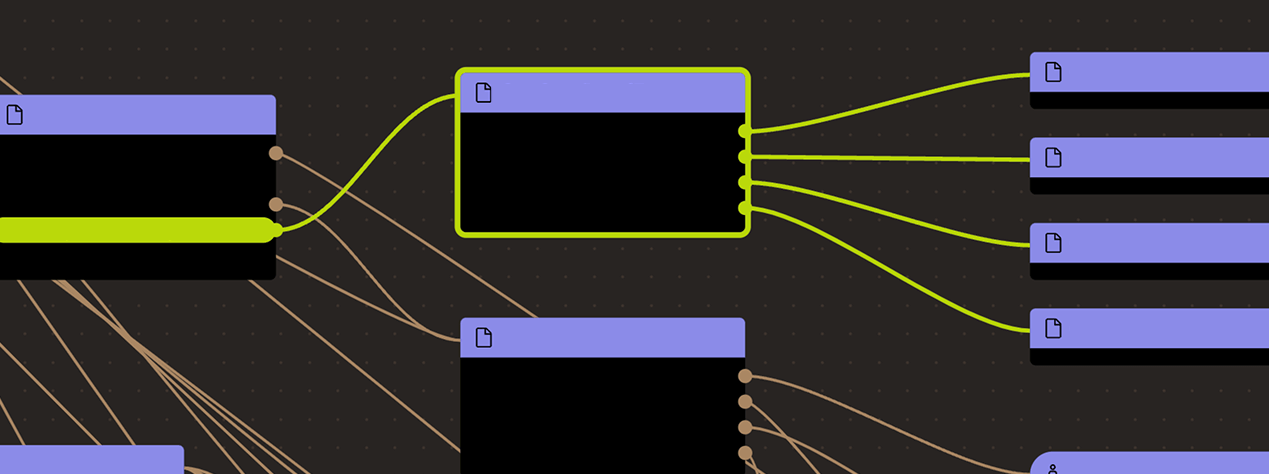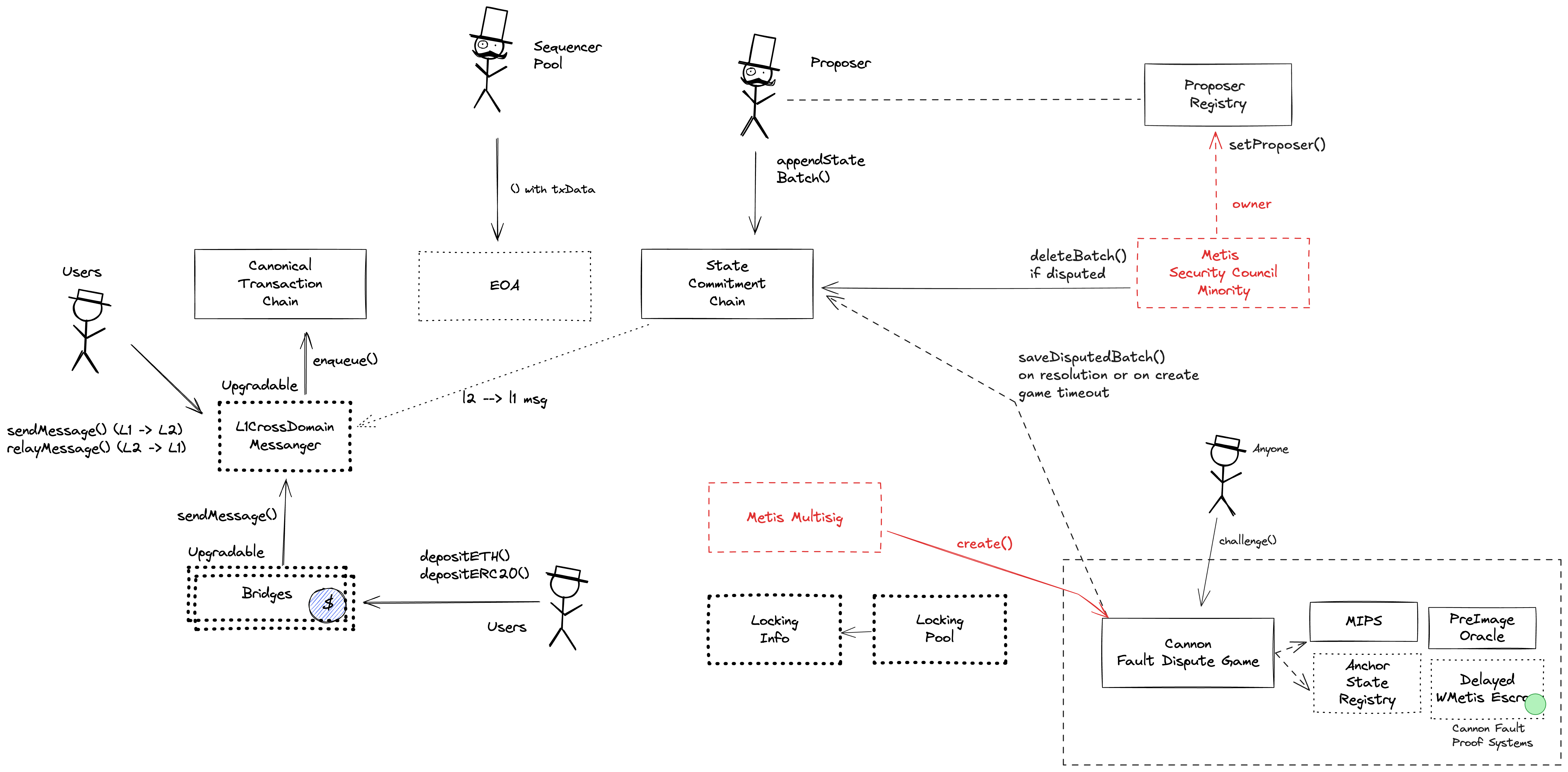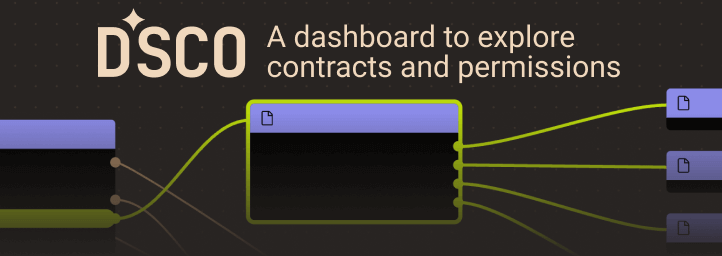Search
Search for projects by name
 Metis Andromeda
Metis Andromeda
Badges
About
Metis Andromeda is an EVM-equivalent solution originally forked from Optimism OVM. It uses a decentralized Sequencer pool running Tendermint consensus and MPC module to sign transaction batches.
Badges
About
Metis Andromeda is an EVM-equivalent solution originally forked from Optimism OVM. It uses a decentralized Sequencer pool running Tendermint consensus and MPC module to sign transaction batches.
Why is the project listed in others?
The current proof system is forked from the standard permissionless OP stack proof system. Importantly, new state root proposals do not create new dispute games and although challenge requests can be made by any bonded user, creating dispute games (creator role) and deleting a state root (state deleter role) after winning a challenge is not permissionless.
Consequence: projects without a sufficiently decentralized set of challengers rely on few entities to safely update the state. A small set of challengers can collude with the proposer to finalize an invalid state, which can cause loss of funds.
Learn more about the recategorisation here.
2024 Nov 22 — 2025 Nov 21
The section shows the operating costs that L2s pay to Ethereum.
2025 May 14 — Nov 21
This section shows how much data the project publishes to its data-availability (DA) layer over time. The project currently posts data to![]() Ethereum.
Ethereum.
2025 May 14 — Nov 21
This section shows how "live" the project's operators are by displaying how frequently they submit transactions of the selected type. It also highlights anomalies - significant deviations from their typical schedule.
Data hashes posted to EOA
2023 Mar 15th
Hashes to data blobs are now posted to EOA address instead of CanonicalTransactionChain contract.
Funds can be stolen if
Funds can be lost if
Funds can be frozen if
Users can be censored if
MEV can be extracted if
Fraud proofs allow actors watching the chain to prove that the state is incorrect. Interactive proofs (INT) require multiple transactions over time to resolve.Anyone can submit challenge requests. However, permissioned actors are needed to create the challenge and to delete successfully disputed state roots. Additionally, the current permissioned actors (GameCreator and Security Council minority) can collude and finalize malicious state roots.
All of the data needed for proof construction is published on Ethereum L1.
There is no window for users to exit in case of an unwanted regular upgrade since contracts are instantly upgradable.
Only the whitelisted proposer can update state roots on L1, so in the event of failure the withdrawals are frozen. The Security Council minority can be alerted to enforce censorship resistance because they own the proposer registry, controlling the active whitelisted proposer.
All data required for proofs is published on chain
Transaction data is posted to Ethereum using blobs. Initially, data was posted to the CanonicalTransactionChain contract, then it moved to just posting hashes to an EOA address, and as of May 2025, the system uses blobs for data availability.
Dispute game contracts for state validation are deployed but not used to propose state roots as in standard OP Stack chains. Instead, the permissioned proposer submits state roots through the appendStateBatch function in the StateCommitmentChain contract. A state root gets confirmed if the challenge period has passed and the state batch is not disputed.
Games can only be created on demand by the permissioned GameCreator should a dispute be requested. Users can signal the need for a dispute by bonding 4.0 METIS and calling the dispute() function of the DisputeGameFactory. If a game is not created by the GameCreator within the dispute timeout period of 2d, anyone can call disputeTimeout(). This function calls saveDisputedBatchTimeout() on the StateCommitmentChain, which marks the batch as disputed. This blocks L2->L1 messaging and withdrawals for the disputed batch and any subsequent batches until the dispute is deleted. Should a game be created and resolved, disputed state batches can be marked as such in the StateCommitmentChain. Then, these flagged batches can be deleted (within the fraud proof window). Batches can only be deleted by the MVM_Fraud_Verifier contract address, which currently corresponds to the Metis Security Council minority.
Funds can be frozen if an invalid state root is successfully disputed but it is not deleted by the permissioned MVM_Fraud_Verifier (Metis Security Council minority).
Funds can be stolen if the GameCreator colludes with the StateDeleter to block Challenges in the proof system (CRITICAL).
The system has a decentralized sequencer set
As of April 2024 Metis uses a permissioned sequencer pool running a Tendermint consensus. Once consensus is reached on a block, an MPC address is used to submit a block hash to Ethereum. The infrastructure to manage the MPC is offchain and not trustless because Ethereum does not verify the validity of MPC address.
MEV can be extracted if the operator exploits their centralized position and frontruns user transactions.
Users can't force any transaction
There is no general mechanism to force the sequencer to include the transaction.
Users can be censored if the operator refuses to include their transactions.
Regular messaging
Funds can be frozen if the centralized validator goes down. Users cannot produce blocks themselves and exiting the system requires new block production (CRITICAL).
EVM compatible smart contracts are supported
Metis uses the Optimistic Virtual Machine (OVM) 2.0 to execute transactions.
Funds can be lost if there are mistakes in the highly complex OVM implementation.

Ethereum
Roles:
Allowed to post new state roots of the current layer to the host chain.
Allowed to commit transactions from the current layer to the host chain.
Can create new dispute games.
Can delete batches from the StateCommitmentChain.
Actors:
A Multisig with 6/8 threshold.
- Can upgrade with no delay
- L1CrossDomainMessenger
- LockingInfo ProxyAdmin
- DisputeGameFactory ProxyAdmin
- FaultProofLockingPool ProxyAdmin
- L1StandardBridge
- MVM_InboxSenderManager
- StateCommitmentChain
- LockingPool ProxyAdmin
- DelayedWMetis ProxyAdmin
A Multisig with 4/9 threshold. Can pause, censor, instantly upgrade the bridge and upgrade other critical contracts in the system.
- A dispute game creator - acting directly
A Multisig with 2/8 threshold.
- A state deleter - acting directly
A Multisig with 2/4 threshold. Escrows staking rewards for Sequencers.
- A dispute game creator - acting directly
- A Sequencer - acting directly
- A Proposer - acting directly


Ethereum
The L1 Cross Domain Messenger (L1xDM) contract sends messages from L1 to Metis, and relays messages from Metis onto L1. In the event that a message sent from L1 to Metis is rejected for exceeding the Metis epoch gas limit, it can be resubmitted via this contract’s replay function.
- Roles:
- admin: Metis Security Council
The Canonical Transaction Chain (CTC) contract is an append-only log of transactions which must be applied to the OVM state. Given that transactions batch hashes are sent to an EOA address, it allows any account to enqueue() a transaction, which the Sequencer must eventually append to the rollup state.
The State Commitment Chain (SCC) stores a list of proposed state roots in a linked ChainStorageContainer contract. Only a permissioned state root proposer (MVM_Proposer) can submit new state roots.
- Roles:
- admin: Metis Security Council
Contract acting as an escrow for METIS tokens managed by LockingPool.
- Roles:
- admin: ProxyAdmin; ultimately Metis Security Council
Storage container for SCC batches.
Factory contract for creating dispute games. Unlike in standard OP Stack chains, games are not created to propose state roots. Instead, games are created on demand by the permissioned GameCreator only should a dispute arise.
- Roles:
- admin: ProxyAdmin; ultimately Metis Security Council
- gameCreator: EOA 1, Metis Multisig
Contract used to manage configuration of global Metis values.
The FaultProofLockingPool is a contract that allows sequencers to lock their funds for a certain period of time. The contract is used in the Metis protocol to ensure that sequencers have enough funds to cover the potential losses from disputes. It currently has a balance of 0 METIS.
- Roles:
- admin: ProxyAdmin; ultimately Metis Security Council
Storage container for CTC batches.
Contract for handling fault disputes (should games be created). Successfully disputed batches are marked as disputed to the StateCommitmentChain.
Main entry point for users depositing ERC20 tokens and ETH that do not require custom gateway.
- Roles:
- admin: Metis Security Council
- This contract can store any token.
The Bond Manager contract will handle deposits in the form of an ERC20 token from bonded Proposers. It will also handle the accounting of gas costs spent by a Verifier during the course of a challenge. In the event of a successful challenge, the faulty Proposer’s bond will be slashed, and the Verifier’s gas costs will be refunded. Current mock implementation allows only OVM_Proposer to propose new state roots. No slashing is implemented.
Oracle for providing preimages.
Oracle specifying user fees for sending L1 -> Metis messages and other parameters for cross-chain communication.
Container contract for designated sequencer addresses.
- Roles:
- admin: Metis Security Council
- blobBatcher: EOA 2
- Roles:
- owner: Metis Security Council
Contract used to manage a mapping of string names to addresses. Modern OP stack uses a different standard proxy system instead, but this contract is still necessary for backwards compatibility with several older contracts.
- Roles:
- 1088_MVM_FraudVerifier: Metis Security Council Minority
- _1088_MVM_Proposer: EOA 3
Metis token contract.
Storage container for CTC queue.
Contract allowing users to lock tokens to apply to become a sequencer, receive rewards, unlock tokens to exit the sequencer, reward distribution.
- Roles:
- admin: ProxyAdmin; ultimately Metis Security Council
Delayed wrapped Metis token contract.
- Roles:
- admin: ProxyAdmin; ultimately Metis Security Council
Metis Andromeda
The current deployment carries some associated risks:
Funds can be stolen if a contract receives a malicious code upgrade. There is no delay on code upgrades (CRITICAL).
